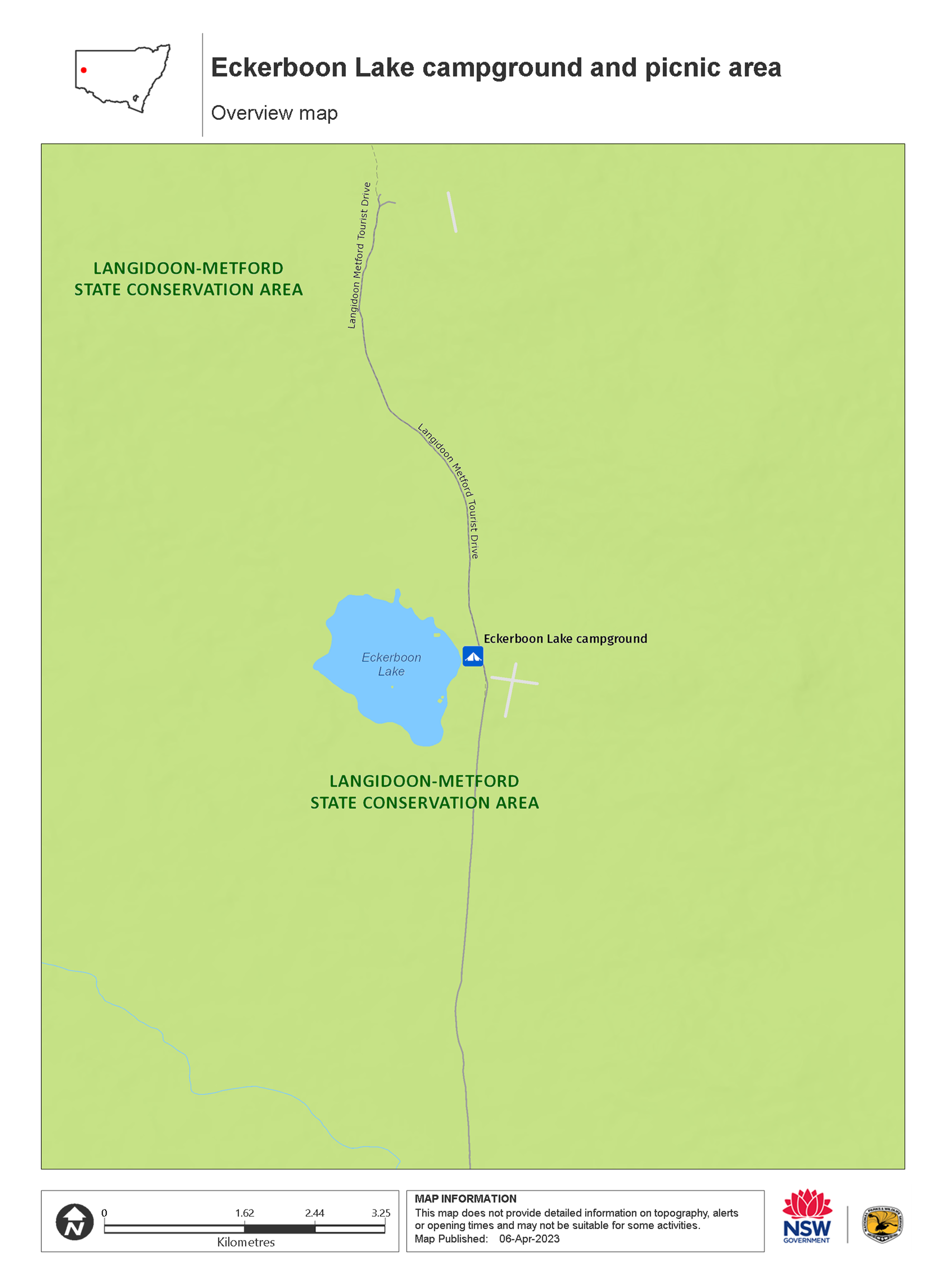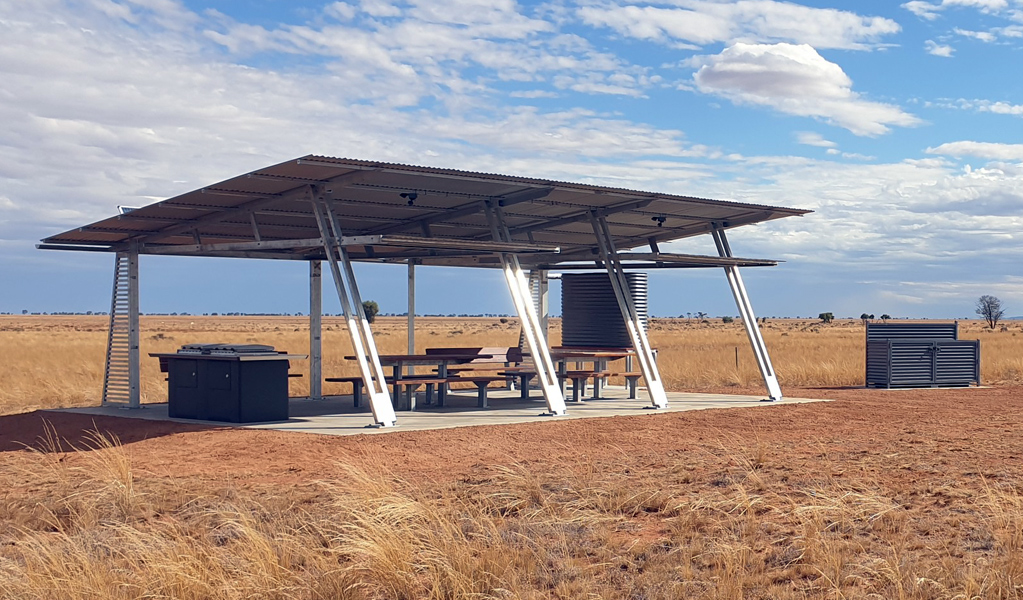Eckerboon Lake campground and picnic area
Langidoon-Metford State Conservation Area
Overview
Camp under the vast open skies of the outback at Eckerboon Lake campground, about 1 hour from Broken Hill.
| Number of campsites | 12 |
|---|---|
| Camping type | Tent, Camper trailer site, Caravan site, Camping beside my vehicle |
| Facilities | Picnic tables, barbecue facilities, carpark, toilets |
| What to bring | Drinking water, cooking water, toilet paper, food supplies, firewood, fuel stove, ice, torch, satellite phone, personal locator beacon, compass, first aid kit, topographic map, gps, insect repellent, sunscreen |
| Bookings | Book up to 12 people or 2 sites online. |
| Group bookings | This campground is not suitable for group bookings. |
| Please note | This is a remote campground, please arrive well prepared. Tell family or friends about your trip. |
If you're a self-sufficient camper, stay at Eckerboon Lake campground. A great stop if you're on a Broken Hill road trip along the Barrier Highway, set up your tent or caravan under the clear skies and admire the colourful sunsets, sunrises and stargazing of Outback NSW.
As you cook up a hot barbecue breakfast, enjoy views of the park's rolling plains. Then explore the nearby shearing sheds, and take a leisurely stroll along the Lake View Woolshed short walk.
Spring is an ideal time to stay, with its warm days and cooler nights. And after rainfall, beautiful displays of mauve, yellow and white wildflowers blanket the landscape. Keep an eye out for darling peas and paper daisies, as well as tracts of mulga and nelia shrub which light up with bright yellow flowers in spring. At dawn and dusk you might see red kangaroos, emus or an elusive short-beaked echidna.
Map

Map legend

Local alerts
For the latest updates on fires, closures and other alerts in this area, see https://www.nationalparks.nsw.gov.au/camping-and-accommodation/campgrounds/eckerboon-lake-campground-picnic-area/local-alerts
Operated by
- Broken Hill office
- Monday to Friday, 8.30am to 4.30pm. Closed 1pm to 2pm.
- 08 8084 2880
- npws.westdarling@environment.nsw.gov.au
- 183 Argent Street, Broken Hill NSW 2880
Park info
- in Langidoon-Metford State Conservation Area in the Outback NSW region
Langidoon-Metford State Conservation Area is always open but may have to close at times due to poor weather or fire danger.
Visitor info
All the practical information you need to know about the Eckerboon Lake campground and picnic area.
Maps and downloads
Learn more
Eckerboon Lake campground and picnic area is in Langidoon-Metford State Conservation Area. Here are just some of the reasons why this park is special:
Large and diverse ecosystems

Langidoon-Metford State Conservation Area has a diverse range of plants and wildlife, as well as rare and threatened ecosystems. Leopardwood trees and pearl bluebush are scattered throughout the park, straggly dead finish line the stony Gibber Hills, and river red gums run alongside the creek. You can often see large birds of prey gliding over the plains, including wedge-tailed eagles, little eagles and harriers. And keep an eye out for the rare Australian bustard, a large ground-dwelling bird that nests near the road into the park, just north of the Barrier Highway.
An ancient region

The age of Langidoon-Metford State Conservation Area is particularly striking. An ancient region, millions of years of weathering has carved out the Gibber Plains and eroded the Barrier Ranges to the west, revealing some of the richest deposits of minerals in Australia. The round, silica rich boulders and rocks covering the sparsely vegetated flatlands give the environment an almost hostile appearance. But the slow rolling hills in the east eventually give way to the flat plains that form the Murray-Darling Basin, and you can see densely forested creek edges on the far horizon.
Aboriginal connections

Langidoon-Metford State Conservation Area is the traditional Country of several Aboriginal peoples who share close connections to this land. Driving through the park you might notice evidence of these connections, including stone quarries, tools and hearths. If you do come across these sites, please respect the significance they have to the Traditional Custodians and simply observe their presence.
Plants and animals protected in this park
Animals
-

Wedge-tailed eagle (Aquila audax)
With a wingspan of up to 2.5m, the wedge-tailed eagle is Australia’s largest bird of prey. These Australian animals are found in woodlands across NSW, and have the ability to soar to heights of over 2km. If you’re bird watching, look out for the distinctive diamond-shaped tail of the eagle.
-

Short-beaked echidna (Tachyglossus aculeatus)
One of only 2 egg-laying mammals in the world, the short-beaked echidna is one of the most widespread of Australian native animals. Covered in spines, or quills, they’re equipped with a keen sense of smell and a tube-like snout which they use to break apart termite mounds in search of ants.
-

Australian pelican (Pelecanus conspicillatus)
The curious pelican is Australia’s largest flying bird and has the longest bill of any bird in the world. These Australian birds are found throughout Australian waterways and the pelican uses its throat pouch to trawl for fish. Pelicans breed all year round, congregating in large colonies on secluded beaches and islands.
-

Emu (Dromaius novaehollandiae)
The largest of Australian birds, the emu stands up to 2m high and is the second largest bird in the world, after the ostrich. Emus live in pairs or family groups. The male emu incubates and rears the young, which will stay with the adult emus for up to 2 years.
-

Red kangaroo (Macropus rufus)
The red kangaroo is one of the most iconic Australian animals and the largest marsupial in the world. Large males have reddish fur and can reach a height of 2m, while females are considerably smaller and have blue-grey fur. Red kangaroos are herbivores and mainly eat grass.
Plants
-

Mulga (Acacia aneura)
Mulga are hardy Australian native plants found throughout inland Australia. With an unusually long tap root, the mulga is able to withstand long periods of drought.
-

River red gum (Eucalpytus camaldulensis)
Australian native plants, majestic river red gum trees are widespread across Australian inland river systems. The river red gum is a dominant tree species of the Murray-Darling basin which spans NSW, Queensland and Victoria. This iconic native eucalypt grows to a height of 30m and is thought to have a lifespan up to 500-1000 years.
-

Saltbush (Atriplex nummularia)
A hardy Australian native plant, the saltbush is a small spreading shrub that can withstand dry salty soils such as those found in the desert plains of western NSW. It is grey-white in colour and has small spear-shaped succulent leaves. It flowers from December to April.
-

Sturt's desert pea (Swainsona formosa)
One of Australia’s most famous desert wildflowers, Sturt’s desert pea is found across inland arid regions of Australia, including far west NSW. One of the most easily-recognised Australian native plants, Sturt’s desert pea thrives in red sandy soil, or loam, and has vibrant red leaf-shaped flowers with a black centre, known as a ‘boss’.

